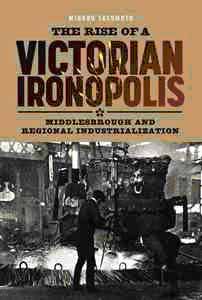
The Rise of a Victorian Ironopolis: Middlesborough and Regional Industrialisation

Minoru Yasumoto
Boydell Press
Woodbridge
2011
ISSN 978-1-84383-633-9
Not for the casual reader, this comprehensive work charts the remarkable rise of Middlesbrough, Britain’s foremost iron town. Middlesborough was a town which grew like ‘topsy’ seemingly overnight. It was said it wasn’t discovered it was manufactured “Cincinnati and Chicago are perhaps the best specimens of American-made towns with which Middlesbrough can be compared: but these do not equal in self-sustaining vigor or rapidly of growth of the Pease-founded colony on the banks of the Tees.” * When the owners of the estate started planning the town in 1831 it contained only 383 inhabitants. As migration increased with the expansion more than half of the population by 1841 came from Yorkshire with 39% of men and 42.8% of women originating elsewhere in England, 5.8% from Ireland and 4.8% from Scotland. As the process continued the Irish population would be greater here than any other English town other than Liverpool.
The community didn’t simply expand it was created from multi-ethnic demographic structure derived from mass influx from Ireland, Wales, Scotland and some countries in continental Europe. It was originally designed as a railway town to transport coal from south west Durham through an extension of the Stockton and Darlington railway by the Ironmasters and local authority. After the discovery of rich Iron ore deposits (in 1850) the town grew swiftly through the expansion of iron and steel manufacture.
Middlesbrough has been compared with Ballarat in Australia, the Klondike in Canada or the gold rush districts of California, developing an urban identity in an even shorter time frame.
From the mid-nineteenth century they concentrated on manufacturing pig iron, wrought or malleable iron and finished products including rails, plates, bars and angles, these grew spectacularly over the period. 188,000 tons of ironstone in 1851 had increased five times by 1861 and in the next decade grew to four million tons. By 1881 production reached 6.5 million tons, the majority of which stayed locally where it was made into pig iron. Cleveland came to control the world pig iron market, in the period of the 1870s they produced approximately 30% of the countries total pig iron, and 13-15% of the world production, Britain as a whole accounting for 47.3%. In 1871 38% of the 1.8 million tons of pig iron produced on Teesside and 43% of the regions production in 1881 was sent overseas via the port of Middlesborough.
That Cleveland iron and steel occupied such a domestic and international dominance from the mid nineteenth century was largely due to the “Cleveland Practice” of iron making.
“The Cleveland blast furnace was developed specifically to smelt large quantities of relatively low grade ironstone as cheaply as possible and to achieve this, reliance was placed on obtaining maximum thermal efficiency by increasing the height of the furnace stack in order to utilize the heat generated at the base of the furnace to heat the materials being charged in at the top.” **
This system was made possible by the very high load bearing qualities of Durham coke. Thus the disadvantage of poor quality Cleveland ironstone was offset by high quality Durham coke. The Cleveland process was distinctive, the ironstone always calcined (roasted) in a kiln. Blast furnaces were large rising to a height of 80 feet with an average capacity of 30,000 cubic feet. Furnaces were worked with a closed top systems and worked with hot blast together with a wide range of material handling technologies .
“In America nine blast furnace men made 260 tons a week on average, while in the United Kingdom six blast furnace men produced 460 tons a week.” ***
The main domestic market for Cleveland pig iron was Scotland, Wales and Newcastle, of these Scotland was by far and away the greatest accounting for nearly 70% of total coastwide export. Besides this 500,000 tons were carried overland by rail to Manchester , Leeds, Bradford and other towns where pig iron was smelted in foundries into cast iron or worked at forges into wrought iron which found their main export markets in the USA, but also Russia, Germany, Netherlands, Belgium, France, India and Australia. The most important item until the mid 1870s was rails, to fuel the insatiable demand for railway expansion.
A whole chapter is devoted to a case study of the initially voluntary North Ormesby Hospital, and the development of medical facilities provided by workers themselves through popular subscription. The town’s working class spearheaded a wide range of self organizations driven by the rapid industrial development as well as the human causalities of the manic industrial process.
The great strike and lock out in 1865 and 1866 had deep and lasting effects on the industrial relations culture of the steel industry in Cleveland and by example nationwide. Iron and steel were among the first industries to recognize workers organizations in order to tie them into sophisticated binding arbitration machinery. The nature of the plants and ongoing industrial processes made them highly vulnerable to wildcats and wholesale industrial action. The great strike of 1866 had driven the creation of the Board Of Arbitration and Conciliation for the North of England Manufactured Iron Trade, to head off class conflict and tie workers into the machinery of industrial development and governance. From the late 1860s to the end of the nineteenth century the joint arbitration board had introduced a sliding scale to fix wage rates. Unlike the coal industry where a similar sliding scale had ensured systematic forcing down of wages to poverty levels and lower, causing mass upsurges of industrial militancy and anti bureaucratic struggles; in the iron industry the scale, doubtless with knowledge of insight from the neighbouring coal industry, didn’t work in this way. The scale, though tying the workers and the union into the corporate body of the industry seems to have worked to the advantage of the workers, at least when compared to other industries and regions.
“In 1869 its first verdict was to raise wages from 8s to 8s 6d per ton. In 1872 came an increase in puddlers wages of one shilling per ton, followed by a further rise of 2s bringing the puddlers pay to 2s 6d per ton. The following year they had a further 9d. While these improvements in pay did not proportionally match the ironmasters increases in profits, and of course there were intermittent falls, the institutions effectiveness in rising wage levels should not be dismissed. Between 1870 and 1880 above all in the first half of the 1870s there was a sharp rise in ironworkers pay and in real earnings on Teesside.” ****
Lest anyone draw the conclusion that paternalist incorporation and kindly employers are the answer we should note that this response was, in fear of the workers exercising militant tactics, or developing less conciliatory organizations.
The whole period of migration seen a massive unbalancing of gender proportions as overwhelmingly it was men and young men who were on the move and sinking new roots. In this as in a number of others the scene must have resembled frontier and gold rush towns of America and Australia.
Middlesbrough’s contribution to the industrial development of Britain and the world is in many ways pioneering and unique. This study largely a statistical economic history work will doubtless become a chief authority on industrialization and rapid urban development. The tables of statistics carefully and painstakingly collected are of immense importance to historians both in their own right and in comparative studies of similar developments now taking place in the developing world for example.
Minoru Yasumoto is Professor in the Faculty of Economics at Kornazawa University, Japan.
David Douglass.